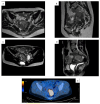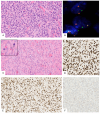Endometrial Stromal Sarcoma: An Update
- PMID: 40507372
- PMCID: PMC12153635
- DOI: 10.3390/cancers17111893
Endometrial Stromal Sarcoma: An Update
Abstract
Endometrial stromal sarcoma (ESS) is a rare malignant tumor of uterine mesenchyme, accounting for 15-20% of uterine sarcomas. It is classified into low-grade (LG-ESS) and high-grade (HG-ESS) subtypes, each defined by distinct histopathological and molecular features. LG-ESS exhibits slow progression, resembling proliferative-phase endometrial stroma, with genetic alterations like JAZF1-SUZ12 fusions. HG-ESS is more aggressive, characterized by high mitotic activity, necrosis, and genetic markers such as BCOR internal tandem duplication, often leading to advanced-stage diagnosis. Surgical resection is the cornerstone for managing early-stage ESS. A total hysterectomy with bilateral salpingo-oophorectomy (BSO) is recommended to prevent recurrence. Fertility-preserving approaches may be considered in LG-ESS but are associated with high recurrence rates. Lymphadenectomy is not routinely performed, given its limited prognostic value. HG-ESS, due to its aggressiveness, often requires additional treatment, including chemotherapy. Adjuvant therapy varies by subtype. LG-ESS responds well to hormonal treatments such as aromatase inhibitors and progestins, while tamoxifen is contraindicated. HG-ESS, lacking hormonal receptor expression, is managed with chemotherapy, often incorporating doxorubicin-based regimens. Radiotherapy may improve local control in select cases but shows limited impact on overall survival. Advanced-stage ESS treatment focuses on complete cytoreduction, supplemented by systemic therapies. Hormonal therapy remains the standard for advanced LG-ESS, whereas HG-ESS relies on chemotherapy. Prognosis depends on the subtype and stage. LG-ESS has favorable outcomes, with five-year survival exceeding 90% in early stages, but recurrent disease remains common. HG-ESS is associated with poorer survival due to its aggressive nature. Advances in molecular profiling offer promising avenues for personalized therapies, integrating genomic insights with targeted treatments to improve outcomes in this rare malignancy.
Keywords: endometrial stromal sarcoma; gynecologic oncology; uterine sarcoma.
Conflict of interest statement
The authors declare no conflicts of interest.
Figures




References
-
- IARC Publications—WHO Classification of Tumours of Female Reproductive Organs. Fourth Edition. [(accessed on 29 September 2024)]. Available online: https://www.iarc.who.int/news-events/iarc-publications-who-classificatio....
Publication types
LinkOut - more resources
Full Text Sources

